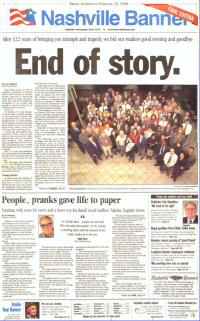The Nashville Banner

Nashville Banner, Final Edition, February 20, 1998
|
|
| Type | Evening Newspaper (Monday–Friday) |
|---|---|
| Format | Broadsheet |
| Owner(s) | Irby C. Simpkins, Jr. Brownlee O. Currey |
| Publisher | Irby C. Simpkins, Jr. |
| Editor | Eddie Jones |
| Managing editors | Tonnya Kennedy |
| Founded | April 10, 1876 |
| Language | English |
| Ceased publication | February 20, 1998 |
| Headquarters | 1100 Broadway, Nashville, Tennessee 37203 |
| Circulation | 40,633 (1998) |
The Nashville Banner is a defunct daily newspaper of Nashville, Tennessee, United States, which published from April 10, 1876 until February 20, 1998. The Banner was published each Monday through Friday afternoon (as well as Saturdays until the 1990s and Sundays until 1937), and at one time carried as many as five editions.
It was long a voice of conservative viewpoints in contrast to its liberal morning counterpart, The Tennessean, although these views were greatly moderated in the paper's twilight years.
The first edition of the Nashville Banner was published on April 10, 1876 as The Nashville Republican Banner, and though it would drop the "Republican" early in its existence, its editorial agenda would resemble that of the political party for which it was initially named. It was begun as a voice for the railroads and other interests in comparison with other area papers of the time which tended to take the viewpoint of workers and unions. It was long controlled by Nashville's influential Stahlman family.
The Banner was an evening paper, which at one time published as many as five editions (first, second, market final, sports final, and sunset final), although these were later consolidated into three editions, and eventually, two. For many years it was in a superior financial condition to its competitors, and in fact, when the rival Tennessean went bankrupt and almost had to cease publication, the Banner assisted in its purchase by the Evans family, who saved it. The Tennessean and the Banner entered into what was one of the first joint operating agreements in the U.S. in 1937. Under this agreement, which became a common model for many other cities over the next half-century, the papers maintained editorial independence and remained separate as news-gathering organizations. However, they were printed on the same presses, distributed by a common agent, and had a consolidated classified advertising department. They were fierce competitors in the realm of news and ideas, but no longer business competitors in the truest sense.
...
Wikipedia
